
Am Fam Physician. 2014;90(6):397-402
Author disclosure: Dr. Ebell is cofounder and editor-in-chief of Essential Evidence Plus, published by Wiley-Blackwell, Inc. Dr. Grad has no relevant financial affiliations.
In 2013, we performed monthly surveillance of more than 110 English-language clinical research journals, and identified approximately 250 studies that had the potential to change the practice of family physicians. Each study was critically appraised and summarized by a group of primary care clinicians with expertise in evidence-based medicine. Studies were evaluated based on their relevance to primary care practice, validity, and likelihood that they could change practice. These summaries, called POEMs (patient-oriented evidence that matters), are e-mailed to subscribers, including members of the Canadian Medical Association. A validated tool was used to obtain feedback from these physicians about the clinical relevance of each POEM and the benefits the physicians expected for their practice. This article, the third installment in this annual series, summarizes the 20 POEMs judged to have the greatest clinical relevance. The included POEMs address questions such as whether patients must fast before measurement of lipids (no), whether a Mediterranean diet reduces mortality (yes), and the likelihood of clinically important bleeding in older patients taking warfarin (3.8% per year).
Since 1994, a group of clinicians with expertise in primary care and evidence-based medicine have performed monthly surveillance of more than 110 English-language research journals.1 Each year, these journals publish more than 20,000 research studies, and we identified 259 that met our criteria for validity, relevance, and practice change. We consider a study valid if it is designed to avoid important biases, such as failure to mask outcome assessors to group assignment, or failure to conceal allocation to the treatment or comparison group. Relevance is defined as a study that reports patient-oriented outcomes, such as morbidity, mortality, or quality of life. We also prioritize studies that would change practice over those that merely confirm existing practice. Studies that meet these criteria are called POEMs, or patient-oriented evidence that matters.2
Since 2005, the Canadian Medical Association (CMA) has sponsored a subscription to POEMs for all of its members. Each member has the option to receive the daily POEM by e-mail. When members read the POEM, they can also rate it with a validated tool called the Information Assessment Method. This tool addresses relevance to clinicians, cognitive impact, use in practice, and expected health benefits if the results of the POEM are applied.3 We identified the 20 POEMs describing original research studies that were rated highest for clinical relevance by CMA members for 2013. At least 70% of CMA members rated each of these POEMs as “totally relevant for at least one of your patients,” whereas less than 15% rated each as “not relevant for at least one of your patients.” Each POEM was rated by between 900 and 1,400 physicians.
Cardiovascular Disease
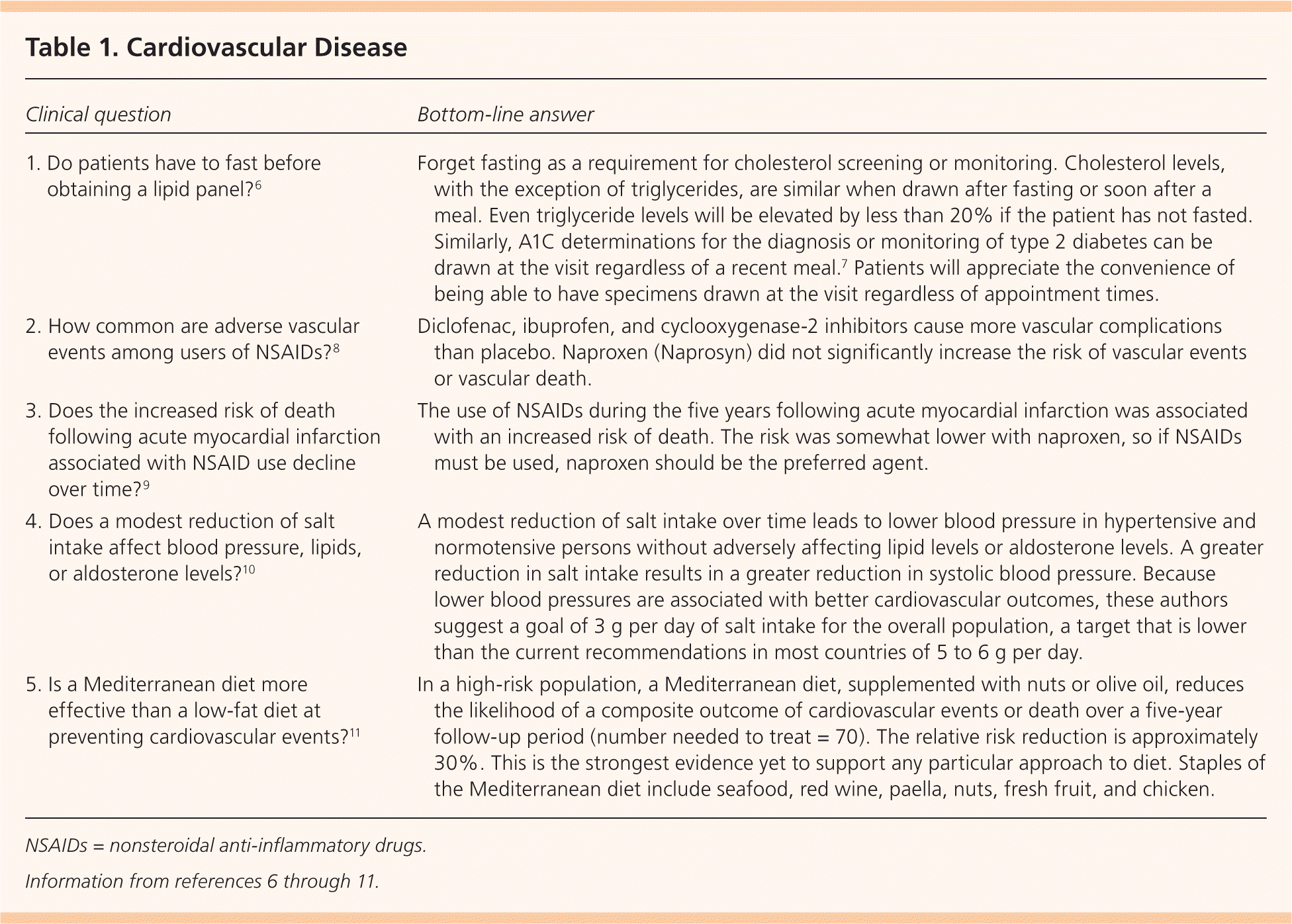
| Clinical question | Bottom-line answer |
|---|---|
| 1. Do patients have to fast before obtaining a lipid panel?6 | Forget fasting as a requirement for cholesterol screening or monitoring. Cholesterol levels, with the exception of triglycerides, are similar when drawn after fasting or soon after a meal. Even triglyceride levels will be elevated by less than 20% if the patient has not fasted. Similarly, A1C determinations for the diagnosis or monitoring of type 2 diabetes can be drawn at the visit regardless of a recent meal.7 Patients will appreciate the convenience of being able to have specimens drawn at the visit regardless of appointment times. |
| 2. How common are adverse vascular events among users of NSAIDs?8 | Diclofenac, ibuprofen, and cyclooxygenase-2 inhibitors cause more vascular complications than placebo. Naproxen (Naprosyn) did not significantly increase the risk of vascular events or vascular death. |
| 3. Does the increased risk of death following acute myocardial infarction associated with NSAID use decline over time?9 | The use of NSAIDs during the five years following acute myocardial infarction was associated with an increased risk of death. The risk was somewhat lower with naproxen, so if NSAIDs must be used, naproxen should be the preferred agent. |
| 4. Does a modest reduction of salt intake affect blood pressure, lipids, or aldosterone levels?10 | A modest reduction of salt intake over time leads to lower blood pressure in hypertensive and normotensive persons without adversely affecting lipid levels or aldosterone levels. A greater reduction in salt intake results in a greater reduction in systolic blood pressure. Because lower blood pressures are associated with better cardiovascular outcomes, these authors suggest a goal of 3 g per day of salt intake for the overall population, a target that is lower than the current recommendations in most countries of 5 to 6 g per day. |
| 5. Is a Mediterranean diet more effective than a low-fat diet at preventing cardiovascular events?11 | In a high-risk population, a Mediterranean diet, supplemented with nuts or olive oil, reduces the likelihood of a composite outcome of cardiovascular events or death over a five-year follow-up period (number needed to treat = 70). The relative risk reduction is approximately 30%. This is the strongest evidence yet to support any particular approach to diet. Staples of the Mediterranean diet include seafood, red wine, paella, nuts, fresh fruit, and chicken. |
The results of Study 1 (Table 16-11 ) may surprise clinicians who have routinely required that their patients fast before obtaining a lipid profile.6 The authors reviewed every lipid panel reported in Calgary for a six-month period (more than 209,000) and found only small differences in the average values of total and low-density lipoprotein cholesterol levels between those who fasted for longer or shorter times, or not at all. Study 2 was a systematic review of 280 clinical trials comparing nonsteroidal anti-inflammatory drugs (NSAIDs) with placebo and 470 trials comparing different NSAIDs with each other.8 The authors found that naproxen (Naprosyn) was not associated with an increased risk of cardiovascular events or deaths, whereas other NSAIDs were. Study 3 involved a similar question, and followed over five years more than 99,000 Danish patients who had experienced an acute myocardial infarction.9 Users of NSAIDs had a higher risk of recurrent events, and although the absolute risk declined over time, the relative risk increase remained the same (1.59 to 1.84). Naproxen led to the smallest increase in risk.
Studies 4 and 5 examined the effect of diet on cardiovascular outcomes. Study 4 was a meta-analysis of studies that reduced salt intake in normotensive and hypertensive individuals.10 The authors found no adverse impact on lipid levels or hormone levels, such as aldosterone (which had been a concern). There was also a reduction in systolic blood pressure of about 1 mm Hg for every 1 g reduction of salt per day. Study 5 stands out for being an adequately powered, well-designed randomized controlled trial of a dietary intervention in a primary care population. It found that a Mediterranean diet significantly reduces the combined outcome of cardiovascular events and death.11
Respiratory Disease
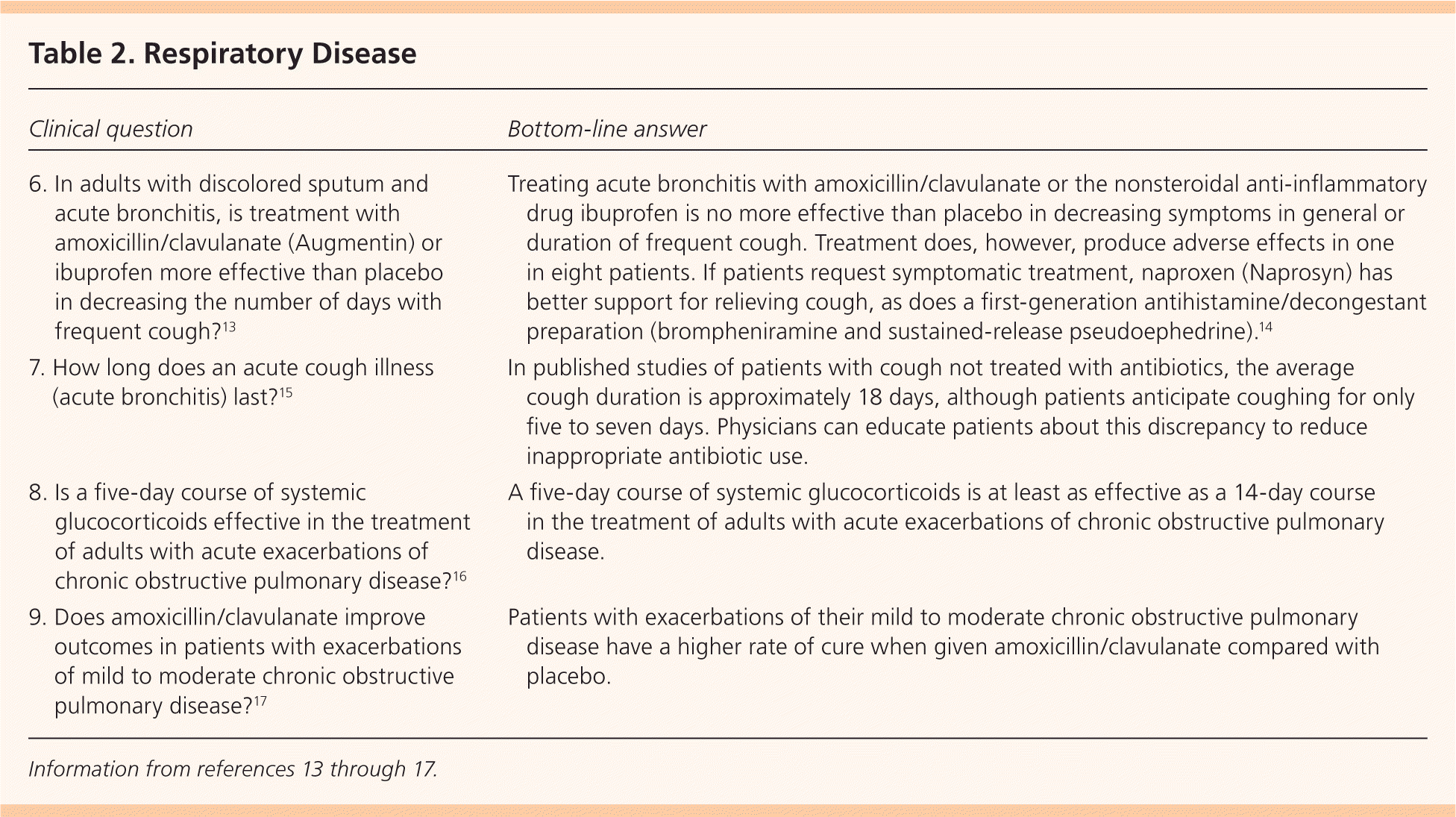
| Clinical question | Bottom-line answer |
|---|---|
| 6. In adults with discolored sputum and acute bronchitis, is treatment with amoxicillin/clavulanate (Augmentin) or ibuprofen more effective than placebo in decreasing the number of days with frequent cough?13 | Treating acute bronchitis with amoxicillin/clavulanate or the nonsteroidal anti-inflammatory drug ibuprofen is no more effective than placebo in decreasing symptoms in general or duration of frequent cough. Treatment does, however, produce adverse effects in one in eight patients. If patients request symptomatic treatment, naproxen (Naprosyn) has better support for relieving cough, as does a first-generation antihistamine/decongestant preparation (brompheniramine and sustained-release pseudoephedrine).14 |
| 7. How long does an acute cough illness (acute bronchitis) last?15 | In published studies of patients with cough not treated with antibiotics, the average cough duration is approximately 18 days, although patients anticipate coughing for only five to seven days. Physicians can educate patients about this discrepancy to reduce inappropriate antibiotic use. |
| 8. Is a five-day course of systemic glucocorticoids effective in the treatment of adults with acute exacerbations of chronic obstructive pulmonary disease?16 | A five-day course of systemic glucocorticoids is at least as effective as a 14-day course in the treatment of adults with acute exacerbations of chronic obstructive pulmonary disease. |
| 9. Does amoxicillin/clavulanate improve outcomes in patients with exacerbations of mild to moderate chronic obstructive pulmonary disease?17 | Patients with exacerbations of their mild to moderate chronic obstructive pulmonary disease have a higher rate of cure when given amoxicillin/clavulanate compared with placebo. |
A previous POEM found no benefit of azithromycin (Zithromax) for treatment of acute bronchitis in healthy adults.12 Study 6 (Table 213–17 ) confirms a lack of benefit with amoxicillin/clavulanate (Augmentin) as well.13 The authors randomized 416 adults to an antibiotic, ibuprofen, or placebo, and found no difference regarding any outcomes. Part of the frustration that patients and physicians have with acute bronchitis is related to its duration. Study 7 found that lower respiratory cough (i.e., acute bronchitis) lasts an average of 18 days from beginning to end, but a poll of adults in Georgia found that they expected it to last only seven days.15 This mismatch may drive requests for an antibiotic (or a second or third), and is something physicians must be aware of as we educate our patients about what to expect.
In Study 8, all patients with an acute chronic obstructive pulmonary disease exacerbation received 40 mg of intravenous methylprednisolone (Solu-Medrol) on the first day, followed by four or 13 days of oral methylprednisolone (Medrol) in a 40-mg daily dose.16 Most patients were hospitalized, and there were no differences between groups in any patient-oriented outcomes, including length of stay. A five-day course of systemic corticosteroids is just as effective as a 14-day course. Study 9 also looked at treatment of mild to moderate acute chronic obstructive pulmonary disease exacerbations, and randomized 310 patients to amoxicillin/clavulanate (500/125 mg three times daily) or placebo.17 The number needed to treat for clinical cure at 10 days was 8 (95% confidence interval, 5 to 27), and those receiving an antibiotic had a longer time before their next exacerbation (233 vs. 160 days).
Screening and Prevention
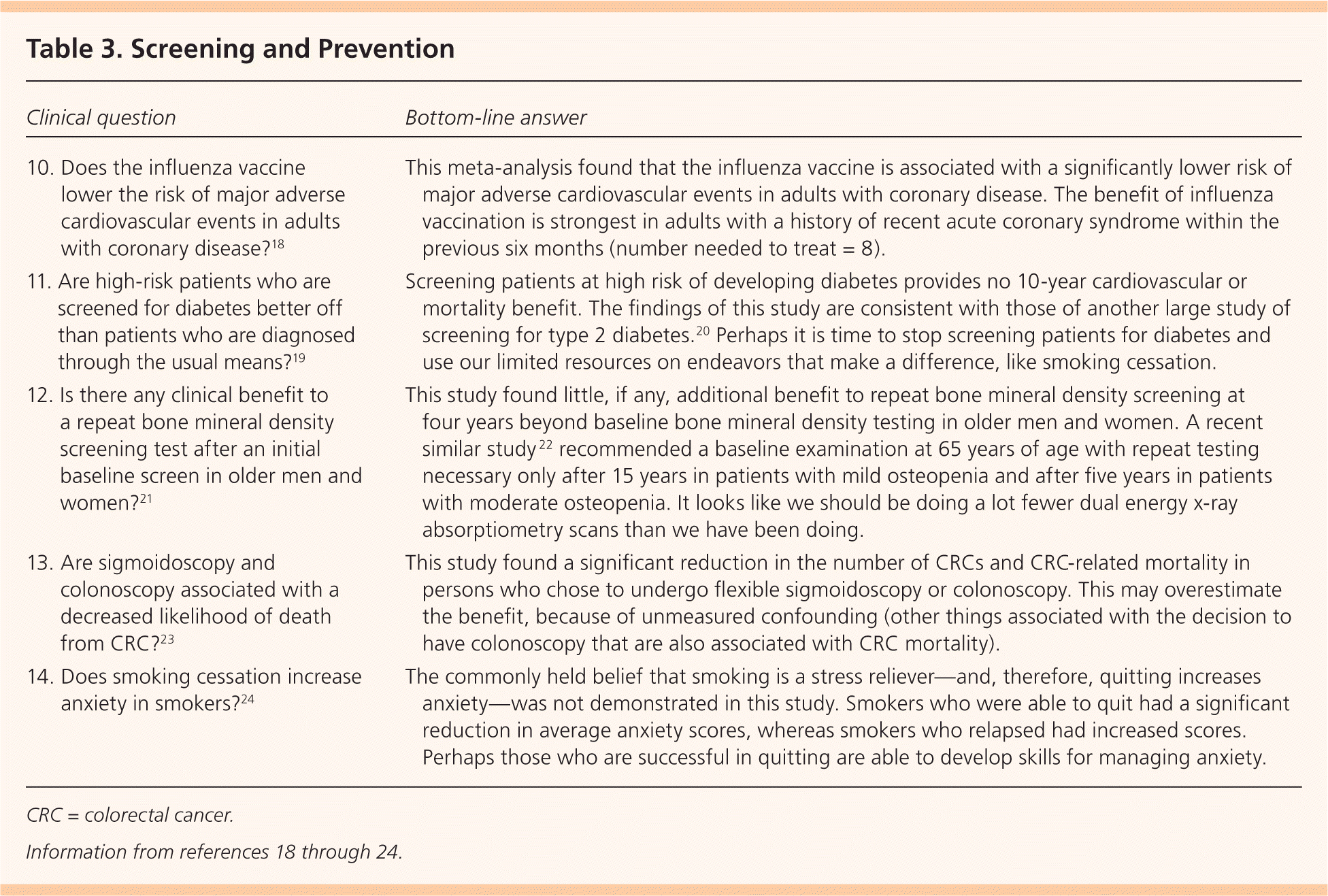
| Clinical question | Bottom-line answer |
|---|---|
| 10. Does the influenza vaccine lower the risk of major adverse cardiovascular events in adults with coronary disease?18 | This meta-analysis found that the influenza vaccine is associated with a significantly lower risk of major adverse cardiovascular events in adults with coronary disease. The benefit of influenza vaccination is strongest in adults with a history of recent acute coronary syndrome within the previous six months (number needed to treat = 8). |
| 11. Are high-risk patients who are screened for diabetes better off than patients who are diagnosed through the usual means?19 | Screening patients at high risk of developing diabetes provides no 10-year cardiovascular or mortality benefit. The findings of this study are consistent with those of another large study of screening for type 2 diabetes.20 Perhaps it is time to stop screening patients for diabetes and use our limited resources on endeavors that make a difference, like smoking cessation. |
| 12. Is there any clinical benefit to a repeat bone mineral density screening test after an initial baseline screen in older men and women?21 | This study found little, if any, additional benefit to repeat bone mineral density screening at four years beyond baseline bone mineral density testing in older men and women. A recent similar study 22 recommended a baseline examination at 65 years of age with repeat testing necessary only after 15 years in patients with mild osteopenia and after five years in patients with moderate osteopenia. It looks like we should be doing a lot fewer dual energy x-ray absorptiometry scans than we have been doing. |
| 13. Are sigmoidoscopy and colonoscopy associated with a decreased likelihood of death from CRC?23 | This study found a significant reduction in the number of CRCs and CRC-related mortality in persons who chose to undergo flexible sigmoidoscopy or colonoscopy. This may overestimate the benefit, because of unmeasured confounding (other things associated with the decision to have colonoscopy that are also associated with CRC mortality). |
| 14. Does smoking cessation increase anxiety in smokers?24 | The commonly held belief that smoking is a stress reliever—and, therefore, quitting increases anxiety—was not demonstrated in this study. Smokers who were able to quit had a significant reduction in average anxiety scores, whereas smokers who relapsed had increased scores. Perhaps those who are successful in quitting are able to develop skills for managing anxiety. |
Study 10 (Table 318–24 ) found that patients with coronary heart disease, and especially those with a recent myocardial infarction or episode of acute coronary syndrome, had the greatest benefit from influenza vaccination.18 Rather than avoiding the influenza shot for fear of causing problems in these patients, we should encourage everyone to get their annual influenza shot. Patients often receive a glucose measurement incidentally or while being evaluated for a symptom or problem, but should we be screening high-risk patients annually for diabetes mellitus? Study 11 was a large cluster randomized trial that found that after 11 years, there was no difference in cardiovascular outcomes, cancer, or mortality between those who were offered screening for diabetes and those who received usual care.19 Bone mineral density testing is often ordered repeatedly for women, but Study 12 found little change in bone density values in older men or women rescreened an average of four years later.21 A previous POEM found that for women with normal bone density levels or mild osteopenia, it would take 15 years for 10% of them to develop osteoporosis.22
There have been no randomized controlled trials of colonoscopy as a screening test for colorectal cancer (although one is underway comparing colonoscopy with fecal immunochemical testing). Study 13 is an observational study that compared persons who chose to have flexible sigmoidoscopy or colonoscopy with those who declined it between 1988 and 2008, and then reported rates of death from colorectal cancer.23 Patients choosing to have colonoscopy had a much lower likelihood of dying of colorectal cancer than those who did not (adjusted hazard ratio = 0.32; 95% confidence interval, 0.24 to 0.45); however, this figure may overestimate the benefit of colonoscopy because volunteers for screening tend to have better outcomes overall than nonvolunteers. Finally, Study 14 examines the impact of smoking cessation on anxiety in 491 smokers who received help quitting smoking.24 Anxiety was lower among those who quit than among persistent smokers.
Renal Disease
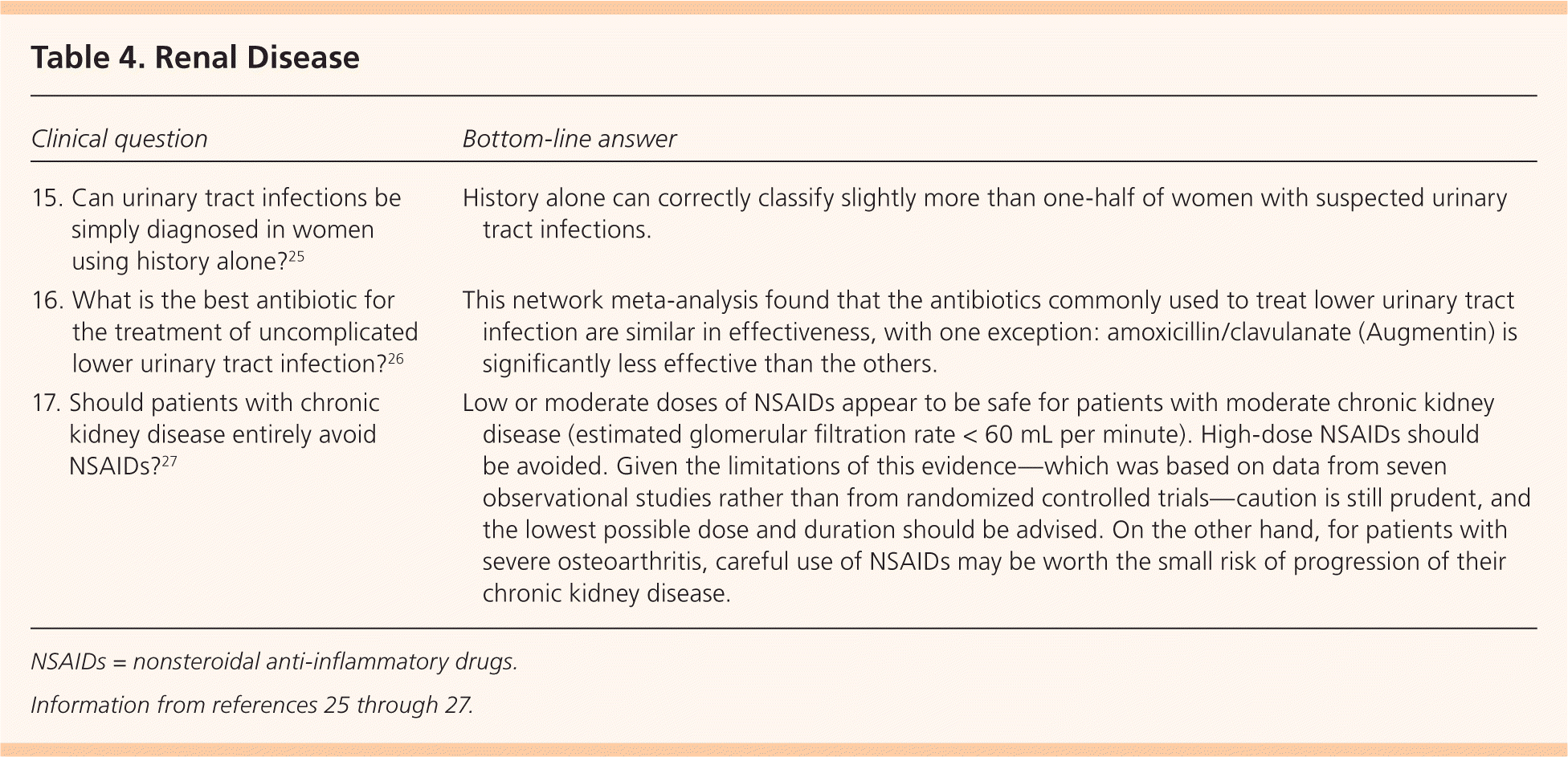
| Clinical question | Bottom-line answer |
|---|---|
| 15. Can urinary tract infections be simply diagnosed in women using history alone?25 | History alone can correctly classify slightly more than one-half of women with suspected urinary tract infections. |
| 16. What is the best antibiotic for the treatment of uncomplicated lower urinary tract infection?26 | This network meta-analysis found that the antibiotics commonly used to treat lower urinary tract infection are similar in effectiveness, with one exception: amoxicillin/clavulanate (Augmentin) is significantly less effective than the others. |
| 17. Should patients with chronic kidney disease entirely avoid NSAIDs?27 | Low or moderate doses of NSAIDs appear to be safe for patients with moderate chronic kidney disease (estimated glomerular filtration rate < 60 mL per minute). High-dose NSAIDs should be avoided. Given the limitations of this evidence—which was based on data from seven observational studies rather than from randomized controlled trials—caution is still prudent, and the lowest possible dose and duration should be advised. On the other hand, for patients with severe osteoarthritis, careful use of NSAIDs may be worth the small risk of progression of their chronic kidney disease. |
Study 15 (Table 425–27 ) followed 196 women with dysuria from Dutch primary care practices to determine the best questions to diagnose lower urinary tract infection (UTI).25 The most important questions for which affirmative answers increased the likelihood of a lower UTI were whether the patient thought she had a lower UTI, whether she had significantly severe dysuria, and whether there was absence of vaginal irritation. There have been 10 studies comparing eight antibiotics for lower UTI, and the authors of Study 16 used a technique called network meta-analysis to compare all of the drugs with each other.26 They found that ciprofloxacin (Cipro) and gatifloxacin were somewhat more effective in the short term, and that amoxicillin/clavulanate was less effective; harms were similar among the drugs.
The conventional wisdom has been that patients with moderate chronic kidney disease, defined as a glomerular filtration rate less than 60 mL per minute, should avoid NSAIDs. Study 17 was a systematic review that revealed that although there was an association between high-dose NSAIDs and renal disease progression, no association was found with lower NSAID doses.27 Although this is not a definitive answer, we can be more comfortable concluding that occasional NSAIDs at modest doses are safe for patients with early or moderate chronic kidney disease.
Miscellaneous
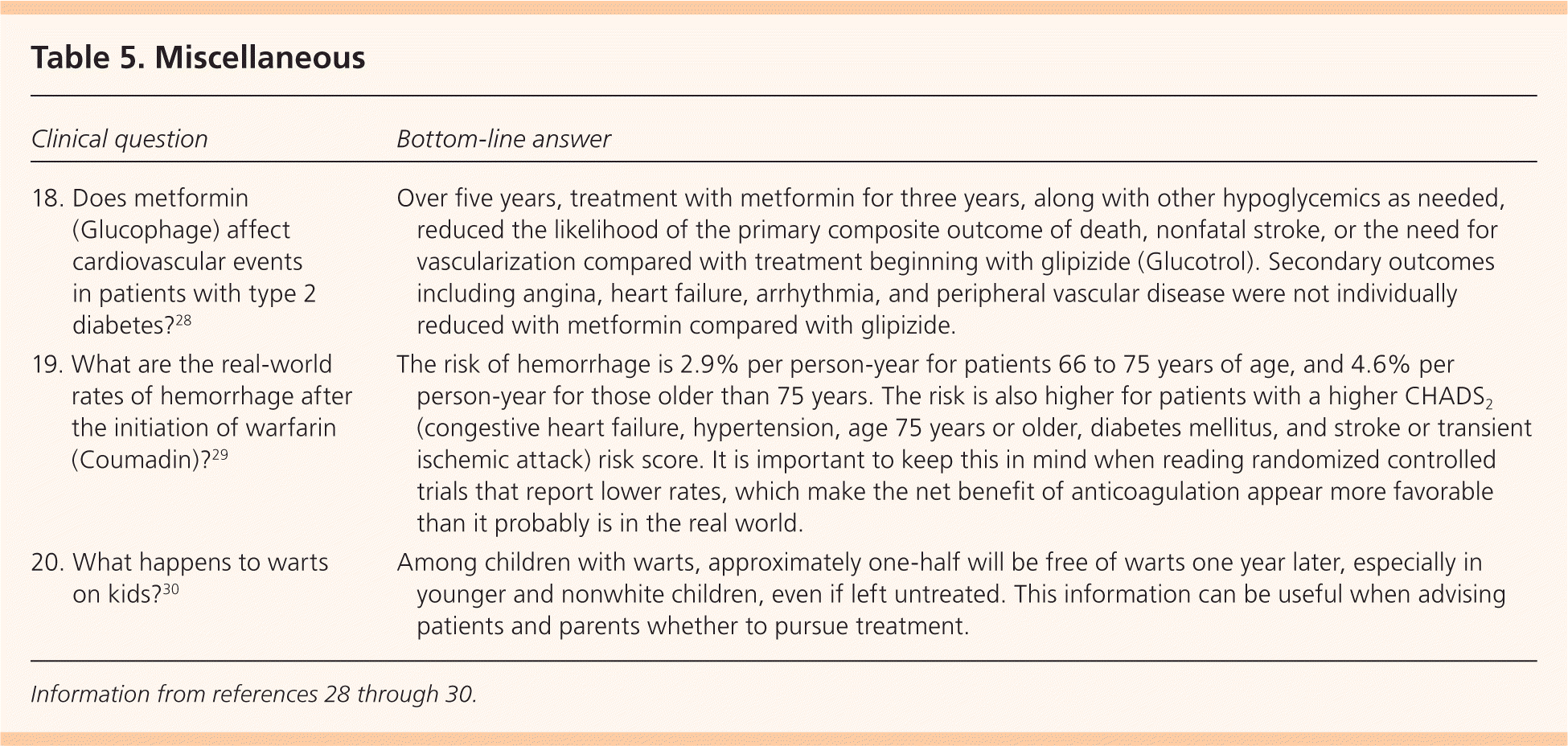
| Clinical question | Bottom-line answer |
|---|---|
| 18. Does metformin (Glucophage) affect cardiovascular events in patients with type 2 diabetes?28 | Over five years, treatment with metformin for three years, along with other hypoglycemics as needed, reduced the likelihood of the primary composite outcome of death, nonfatal stroke, or the need for vascularization compared with treatment beginning with glipizide (Glucotrol). Secondary outcomes including angina, heart failure, arrhythmia, and peripheral vascular disease were not individually reduced with metformin compared with glipizide. |
| 19. What are the real-world rates of hemorrhage after the initiation of warfarin (Coumadin)?29 | The risk of hemorrhage is 2.9% per person-year for patients 66 to 75 years of age, and 4.6% per person-year for those older than 75 years. The risk is also higher for patients with a higher CHADS2 (congestive heart failure, hypertension, age 75 years or older, diabetes mellitus, and stroke or transient ischemic attack) risk score. It is important to keep this in mind when reading randomized controlled trials that report lower rates, which make the net benefit of anticoagulation appear more favorable than it probably is in the real world. |
| 20. What happens to warts on kids?30 | Among children with warts, approximately one-half will be free of warts one year later, especially in younger and nonwhite children, even if left untreated. This information can be useful when advising patients and parents whether to pursue treatment. |
Study 18 (Table 528–30 ) randomized 304 adults with a mean age of 63 years (after stopping their current medicines) to glipizide (Glucotrol), 30 mg daily, or metformin (Glucophage), 1,500 mg daily.28 Additional drugs could be added as needed. After five years, the composite outcome of cardiovascular events or death occurred significantly more often in the glipizide group (35.1% vs. 25%, number needed to treat = 9.4). Metformin should remain the initial choice for management of type 2 diabetes.
If one looked only at randomized trials, one would think that the rate of clinically important bleeding was between 1% and 3% for patients receiving warfarin (Coumadin). Study 19 found that it is somewhat higher in those 65 years or older, approximately 3.8% per year.29 The risk was highest in the first month (1% during that month alone) and higher in patients older than 75 years (4.6% vs. 2.9% for those 66 to 75 years of age).
Finally, Study 20, one of our highest rated POEMs of the year, investigated what happens to warts on children.30 Researchers examined the hands and feet of 1,100 schoolchildren in three Dutch grade schools, and found that about one-third had at least one wart. One year later, one-half of the warts were gone. It did not seem to matter whether the children had undergone any active therapy.
Final Comments
Each of these POEMs is based on an original research study or systematic review. There were also three practice guidelines highly rated by Canadian physicians. The first was an American Academy of Family Physicians/American Academy of Pediatrics joint guideline for the treatment of acute otitis media in children.31 This builds on the previous guideline that encourages watchful waiting, and prescribing antibiotics only for children with a bulging eardrum or otorrhea, pain or intense erythema, and objective evidence of a middle ear effusion by pneumatic otoscopy. The initial antibiotic should be amoxicillin for most children, with amoxicillin/clavulanate as an alternative. The second practice guideline was also from the American Academy of Pediatrics, and addressed the diagnosis and treatment of sinusitis in children.32 Key messages are that (1) children should have symptoms for at least 10 days, severe symptoms for at least three days in a febrile child, or “double-sickening” before considering antibiotics, (2) imaging should be avoided, and (3) amoxicillin with or without clavulanate is the antibiotic of choice. Finally, the American College of Physicians updated its guidelines on prostate cancer screening. Screening in men 50 to 69 years of age is recommended only after shared decision making and expression of a clear preference for screening after a discussion of the “limited potential benefits and substantial harms.”33
editor's note: This article was cowritten by Dr. Mark Ebell who is a member of the U.S. Preventive Services Task Force, deputy editor for American Family Physician (AFP), and cofounder and editor-in-chief of Essential Evidence Plus, published by Wiley-Blackwell, Inc. The POEMs described in this article stem from work that Dr. Ebell and his colleagues have been doing for the past two decades. Medical journals occasionally publish an article summarizing the best studies in a certain field from the previous year; however, those articles are limited by being one person's idiosyncratic collection of a handful of studies. In contrast, this article by Drs. Ebell and Grad is validated in two ways: (1) the source material (POEMs) was derived from a systematic review of thousands of articles using a rigorous criterion-based process, and (2) these “best of the best” summaries were rated by Canadian primary care physicians for relevance and benefits to practice.
Because of Dr. Ebell's dual roles and ties to Essential Evidence Plus, the concept for this article was independently reviewed and approved by a group of AFP's medical editors. In addition, the article underwent peer review and editing by four of AFP's medical editors. Dr. Ebell was not involved in the editorial decision-making process.-Jay Siwek, MD, Editor, American Family Physician
